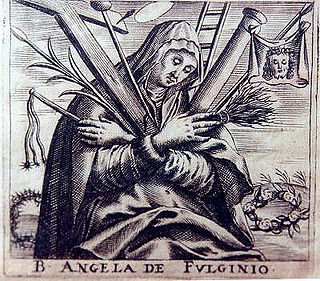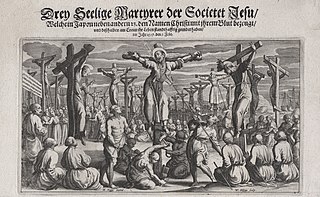
Canonization is the declaration of a deceased person as an officially recognized saint, specifically, the official act of a Christian communion declaring a person worthy of public veneration and entering their name in the canon catalogue of saints, or authorized list of that communion's recognized saints.

In Christian belief, a saint is a person who is recognized as having an exceptional degree of holiness, likeness, or closeness to God. However, the use of the term saint depends on the context and denomination. In Catholic, Eastern Orthodox, Anglican, Oriental Orthodox, and Lutheran doctrine, all of their faithful deceased in Heaven are considered to be saints, but some are considered worthy of greater honor or emulation. Official ecclesiastical recognition, and consequently a public cult of veneration, is conferred on some denominational saints through the process of canonization in the Catholic Church or glorification in the Eastern Orthodox Church after their approval.

Maximilian Maria Kolbe was a Polish Catholic priest and Conventual Franciscan friar who volunteered to die in place of a man named Franciszek Gajowniczek in the German death camp of Auschwitz, located in German-occupied Poland during World War II. He had been active in promoting the veneration of the Immaculate Virgin Mary, founding and supervising the monastery of Niepokalanów near Warsaw, operating an amateur-radio station (SP3RN), and founding or running several other organizations and publications.

In the Catholic Church, the Dicastery for the Causes of Saints, previously named the Congregation for the Causes of Saints, is the dicastery of the Roman Curia that oversees the complex process that leads to the canonization of saints, passing through the steps of a declaration of "heroic virtues" and beatification. After preparing a case, including the approval of miracles, the case is presented to the pope, who decides whether or not to proceed with beatification or canonization.

Beatification is a recognition accorded by the Catholic Church of a deceased person's entrance into Heaven and capacity to intercede on behalf of individuals who pray in their name. Beati is the plural form, referring to those who have undergone the process of beatification; they possess the title of "Blessed" before their names and are often referred to in English as "a Blessed" or, plurally, "Blesseds".
The Venerable is a style, title, or epithet used in some Christian churches.
The process of beatification and canonization has undergone various reforms in the history of the Roman Catholic Church. For current practice, as well as a discussion of similar processes in other churches, see the article on canonization. This article describes the process as it was before the promulgation of the Codex Iuris Canonici of 1983.

José de Anchieta y Díaz de Clavijo, SJ was a Canarian Jesuit missionary to the Portuguese colony of Brazil in the second half of the 16th century. A highly influential figure in Brazil's history in the first century after its European discovery, Anchieta was one of the founders of São Paulo in 1554 and of Rio de Janeiro in 1565. He is the first playwright, the first grammarian and the first poet born in the Canary Islands, and is considered the father of Brazilian literature.

The Forty Martyrs of England and Wales or Cuthbert Mayne and Thirty-Nine Companion Martyrs are a group of Catholic, lay and religious, men and women, executed between 1535 and 1679 for treason and related offences under various laws enacted by Parliament during the English Reformation. The individuals listed range from Carthusian monks who in 1535 declined to accept Henry VIII's Act of Supremacy, to seminary priests who were caught up in the alleged Popish Plot against Charles II in 1679. Many were sentenced to death at show trials, or with no trial at all.
Canonization of Josemaría Escrivá de Balaguer discusses John Paul II's decision to canonize Josemaría Escrivá, founder of the Prelature of the Holy Cross and Opus Dei, more commonly known as Opus Dei.

Margaret of Città di Castello, TOSD was an Italian Catholic educator and a Dominican tertiary. Margaret had disabilities and became known for her deep faith and holiness.

Angela of Foligno was an Italian Franciscan tertiary who became known as a mystic from her extensive writings about her mystical revelations. Due to the respect those writings engendered in the Catholic Church she became known as "Mistress of Theologians".
During the Spanish Civil War Catholic people faced persecution from the Republican faction of the war, in part due to their support of the nationalists and the recently abolished monarchy. The Catholic Church venerates them as martyrs. More than 6,800 clerics and other Catholic people were killed in what has been dubbed the Red Terror. As of November 2023, 2,127 Spanish martyrs have been beatified; 11 of them being canonized. For some 2,000 additional martyrs, the beatification process is underway

The Martyrs of Japan were Christian missionaries and followers who were persecuted and executed, mostly during the Tokugawa shogunate period in the 17th century. The Japanese saw the rituals of the Christians causing people to pray, close their eyes with the sign of the cross and lock their hands together – this was seen as psychological warfare against the Japanese and this was punished as such. More than 400 martyrs of Japan have been recognized with beatification by the Catholic Church, and 42 have been canonized as saints.
The martyrs of Turon is the name given by the Catholic church to a group of eight members of the Catholic, religious-teaching congregation Institute of the Brothers of the Christian Schools, also known as De La Salle Brothers, and one Passionist priest who were executed by insurrectionists in Spain, during the Asturias uprising of October 1934. They were canonized in 1999 by Pope John Paul II.

Anna Schäffer was a German woman who lived in Mindelstetten in Bavaria. She was canonized by Pope Benedict XVI on October 21, 2012.
Events from the year 2014 in Vatican City.
Maiorem hac dilectionem is an apostolic letter issued in the form of a motu proprio of Pope Francis, dated 11 July 2017. The document creates a new path towards sainthood under the canonization procedures of the Roman Catholic Church, through the path of oblatio vitae. This means the offering of one's life and premature death for another individual; it is to give one's life as a sacrifice for another.












